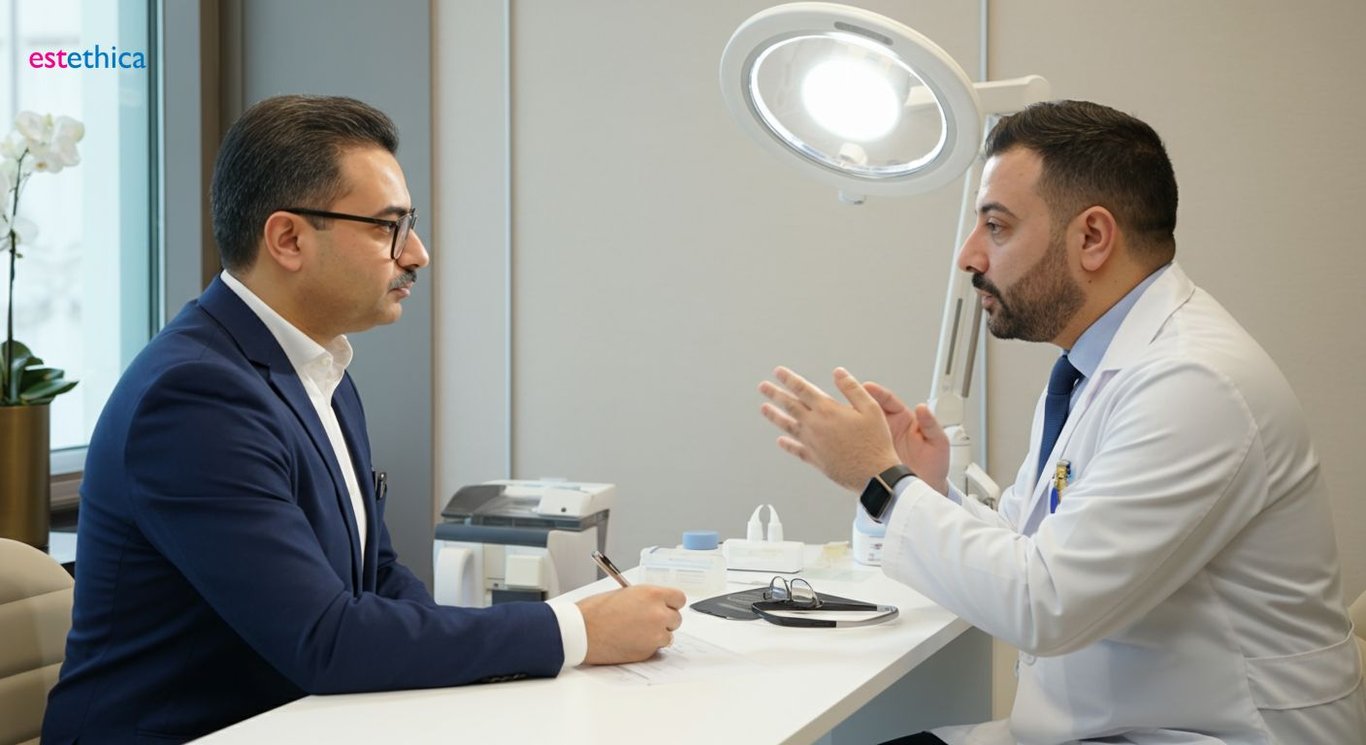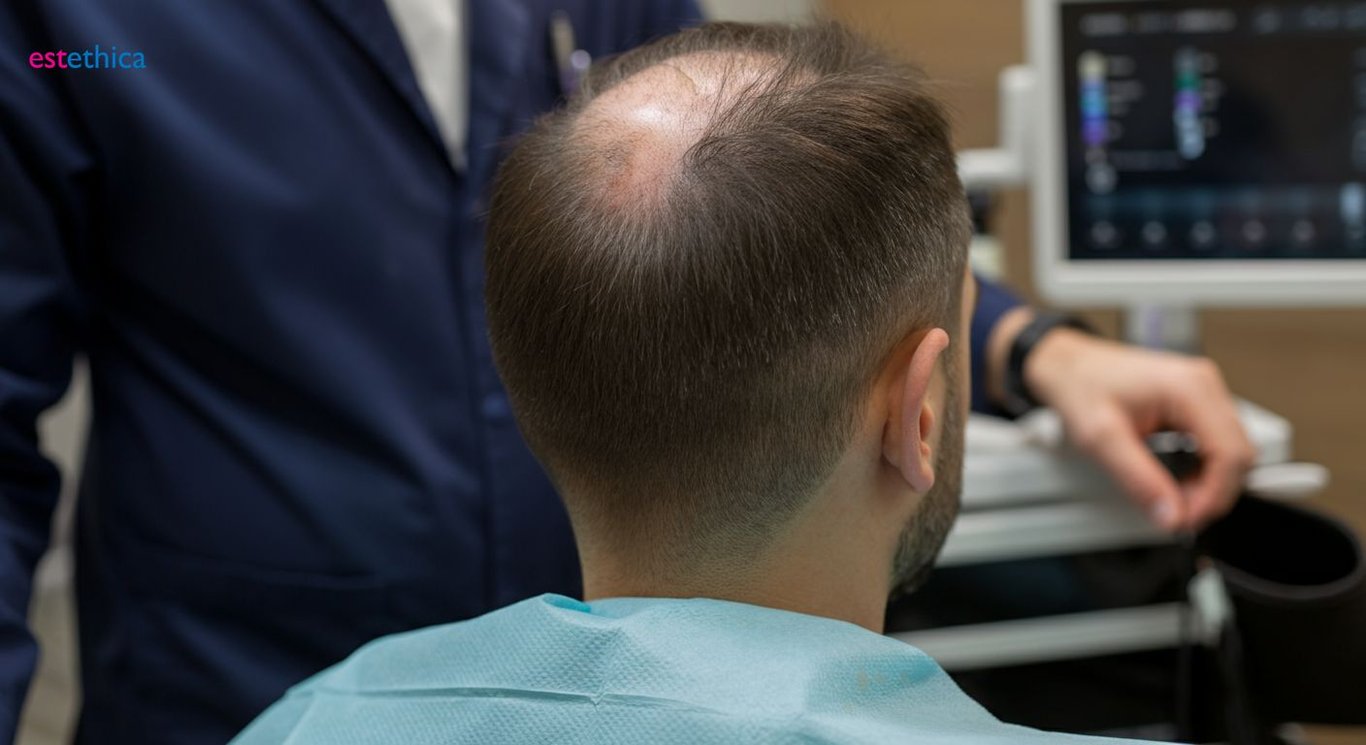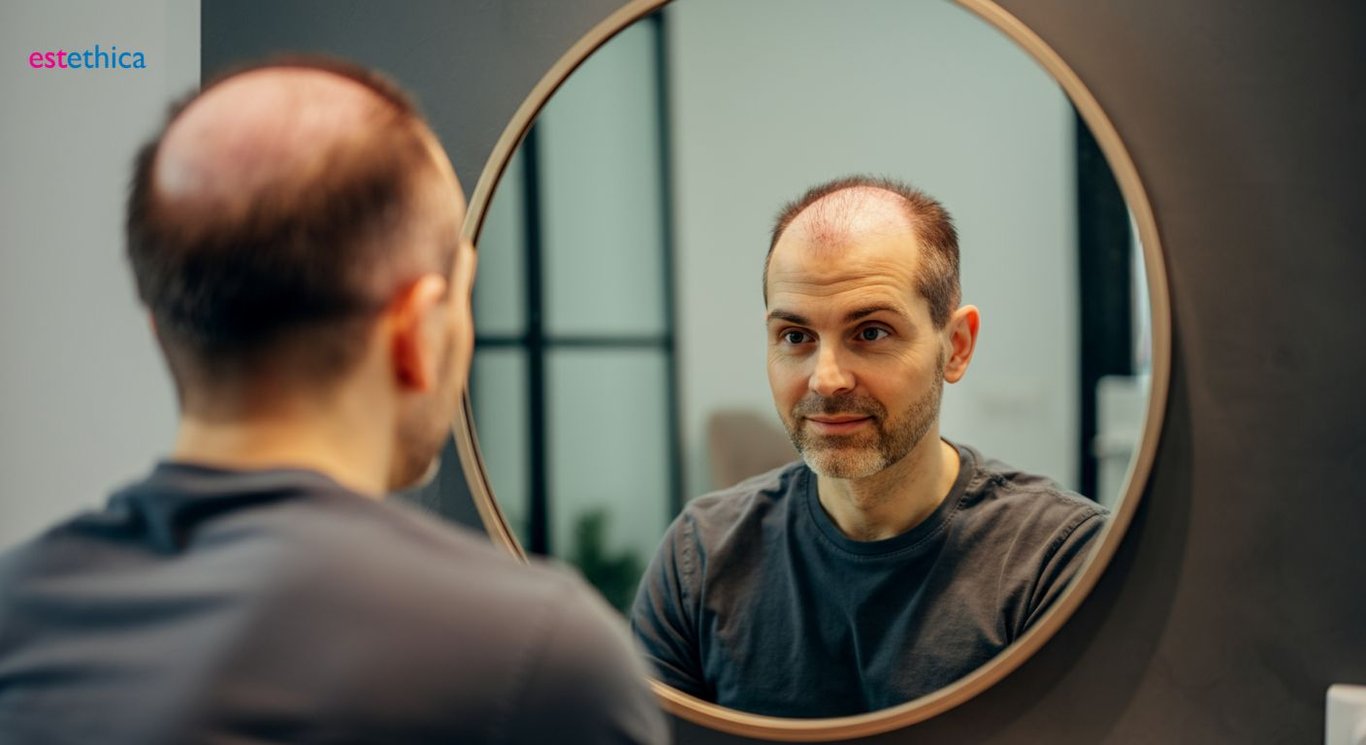Hair Transplant: Unlock Your Natural Hair's Potential
Unlock the full potential of hair restoration with tailored solutions and cutting-edge techniques offered at estethica.
In today's world, where appearance plays a pivotal role in personal and professional life, hair loss can significantly affect self-esteem. Hair transplants have emerged as a popular and effective solution for combatting hair loss and restoring one's youthful looks. This guide will delve into the intricacies of hair transplants, helping you make informed decisions on the journey towards hair restoration.
Understanding Hair Loss: Identifying the Root Cause
Genetic Predisposition and Hair Loss
Genetics are a primary factor in determining susceptibility to hair loss, particularly androgenetic alopecia, commonly known as male or female pattern baldness. This condition involves a genetically determined sensitivity to dihydrotestosterone (DHT), a hormone that can shrink hair follicles. Individuals with a family history of hair loss are more likely to experience it themselves. Identifying this predisposition early can help in proactive management and exploring options like painless unshaven hair transplant, as detailed on https://estethica.com.tr, offering a less invasive solution.
- Family History Assessment: Evaluating the extent and pattern of hair loss among relatives to gauge individual risk.
- Genetic Testing: Emerging technologies offer genetic tests that can predict the likelihood of developing androgenetic alopecia based on specific gene variants.
- Early Intervention: Recognizing genetic predispositions allows for timely adoption of preventive measures such as topical treatments or lifestyle adjustments.
estethica emphasizes a thorough evaluation that includes a detailed family history to better understand the genetic contributions to hair loss. This enables a more targeted and effective approach to treatment, considering individual genetic factors.
Hormonal Factors and Treatment Approaches
Hormonal imbalances significantly impact hair health, particularly in women experiencing conditions like polycystic ovary syndrome (PCOS) or during menopause. These hormonal shifts can lead to increased hair shedding and thinning. Addressing these imbalances is crucial for effective hair restoration. For example, thyroid disorders, which affect hormone production, can also cause diffuse hair loss, highlighting the importance of endocrine evaluations in diagnosing hair loss. A balanced hormonal environment is often necessary to create an encouraging environment for procedures like hair transplants.
- Hormone Level Testing: Conducting blood tests to assess levels of hormones like testosterone, DHT, estrogen, and thyroid hormones to identify imbalances.
- Medication Adjustment: Modifying or introducing medications that regulate hormone levels to mitigate their impact on hair follicles.
- Nutritional Support: Recommending dietary changes and supplements that promote hormonal balance and overall hair health, such as increasing iron or vitamin D intake.
estethica takes a holistic approach by not only addressing the symptoms of hair loss but also investigating and managing the underlying hormonal causes. This ensures a more sustainable and effective outcome for hair restoration treatments.

FUE vs. FUT: Choosing the Right Hair Restoration Technique
Understanding FUE and FUT Techniques
Follicular Unit Extraction (FUE) and Follicular Unit Transplantation (FUT) represent the leading-edge methodologies in hair transplantation. FUE involves the individual extraction of hair follicles directly from the scalp, a method known for leaving minuscule, almost undetectable scars. This is particularly appealing for patients who prefer shorter hairstyles. FUT, on the other hand, involves removing a strip of scalp from which the hair follicles are then extracted. This method may be more suitable for covering larger areas of hair loss in a single session. Understanding the nuances of each technique helps tailor the approach to individual patient needs. Hair replacement surgery is also important when these methods are not enough.
- FUE (Follicular Unit Extraction): Ideal for patients wanting minimal scarring and quicker recovery due to its minimally invasive nature.
- FUT (Follicular Unit Transplantation): Often chosen for addressing extensive hair loss, as it allows for the transplantation of a higher number of grafts at once.
- Personalized Consultation: Essential to assess individual hair loss patterns and determine which technique aligns best with the patient’s expectations and physical characteristics.
Both FUE and FUT have their specific advantages, but they share the same goal: to restore hair and confidence. At estethica, the skilled surgeons carefully assess each patient to recommend the most appropriate technique, ensuring optimal results.
Matching Technique to Patient Needs
The selection between FUE and FUT is driven by various patient-specific factors, including the extent of hair loss, hair type, and personal preferences regarding scarring and recovery time. For example, someone seeking to cover a receding hairline might benefit more from the precision of FUE, whereas someone needing to address significant balding across the crown could find FUT more effective. Also, considerations like lifestyle and activity level play a crucial role in determining the suitability of each procedure. Celebrities like Elon Musk have also been rumored to have undergone similar procedures, sparking interest in hair restoration.
- Assessing Hair Loss Extent: Determining the area that needs coverage to decide which method can provide the most comprehensive solution.
- Evaluating Hair Characteristics: Considering factors like hair density, texture, and color to ensure the transplanted hair blends seamlessly with the existing hair.
- Lifestyle Considerations: Discussing the patient's lifestyle, including their preferred hairstyle and recovery expectations, to align the surgical approach accordingly.
estethica's approach involves a detailed consultation to evaluate these factors, ensuring personalized care that leads to satisfactory and natural-looking hair restoration. This tailored approach considers both the aesthetic goals and the practical aspects of each patient's life, ensuring the best possible outcome for procedures like turkish hair implants.

Beyond the Procedure: Maximizing Hair Transplant Success
Customized Aftercare for Enhanced Hair Growth
The journey to successful hair restoration extends well beyond the surgical procedure. Meticulous post-operative care is essential to ensure optimal graft survival and stimulate robust hair growth. At estethica, we understand that each patient's needs are unique, which is why we offer customized aftercare programs tailored to individual requirements and the specific type of hair transplant performed. This personalized approach maximizes the potential for a natural-looking and long-lasting result. For example, patients receiving turkish hair implants benefit from specialized care protocols designed to support the denser graft placement typical of this technique.
- Individualized Treatment Plans: Tailoring aftercare regimens based on skin type, graft density, and individual healing rates.
- Advanced Wound Care: Utilizing innovative techniques to minimize scarring and promote faster healing of donor and recipient areas.
- Nutritional Guidance: Providing dietary recommendations and supplements that support hair follicle health and accelerate growth.
We prioritize comprehensive support to help our patients achieve the best possible outcomes following their hair transplant.
The Role of Advanced Technologies in Post-Transplant Care
Integrating advanced technologies into post-transplant care can significantly enhance recovery and promote stronger hair growth. estethica employs cutting-edge treatments, such as low-level laser therapy (LLLT), to stimulate blood flow to the scalp and encourage cellular regeneration. These technologies play a crucial role in reducing inflammation, accelerating healing, and improving the overall health of transplanted follicles. Furthermore, we offer patented ointments formulated with growth factors and nutrients to nourish the scalp and support hair follicle development. For instance, post hair replacement surgery, these technologies offer a non-invasive way to improve graft uptake and hair thickness.
- Low-Level Laser Therapy (LLLT): Stimulates hair follicles and improves blood circulation to encourage growth.
- Growth Factor Ointments: Nourishes the scalp and promotes faster healing with specialized formulations.
- Regular Follow-Up Assessments: Monitoring progress and adjusting the aftercare plan to optimize results based on individual responses.
Our commitment to innovation ensures that our patients receive the most advanced and effective care available, maximizing the success of their hair restoration journey after procedures like elon musk hair surgery.

Is a Hair Transplant Permanent? Setting Realistic Expectations
Longevity Factors in Hair Transplant Outcomes
The enduring nature of hair transplants is heavily influenced by several factors, including the surgical technique employed, the quality of the donor hair, and adherence to post-operative care guidelines. Follicular Unit Extraction (FUE) and Follicular Unit Transplantation (FUT) both offer long-term solutions, but their success hinges on the careful selection of healthy, DHT-resistant hair follicles from the donor area. Proper technique ensures these follicles are transplanted in a way that preserves their viability and promotes sustained growth. Additionally, protection from sun damage and maintaining a healthy scalp environment are critical. Cases such as those involving turkish hair implants often showcase excellent long-term results due to advanced techniques and careful execution.
- DHT Resistance: Utilizing hair follicles that are genetically resistant to the effects of dihydrotestosterone to ensure longevity.
- Surgical Precision: Ensuring proper placement and handling of grafts during transplantation to maximize survival rates.
- Post-Operative Care: Following a strict regimen of care, including medication and lifestyle adjustments, to support long-term hair health.
estethica emphasizes a holistic approach, educating patients on how to maintain their transplanted hair for life through optimal care practices.
Managing Expectations and Future Hair Loss
While transplanted hair is designed to be permanent, it's crucial for patients to understand that the natural aging process and potential for ongoing hair loss in non-transplanted areas can still occur. To maintain a full and natural look, some individuals may require additional procedures over time. Managing expectations involves understanding the progressive nature of hair loss and planning for future interventions if needed. This includes considering options like medical treatments to slow down native hair loss or additional transplant sessions to maintain density. Some patients draw inspiration from celebrity hair transplant stories, like speculation around elon musk hair implant, which highlight the transformative yet ongoing nature of hair restoration.
- Assessing Future Hair Loss: Evaluating the patient's pattern of hair loss and predicting potential future thinning to plan accordingly.
- Medical Interventions: Utilizing treatments like minoxidil and finasteride to slow down the progression of hair loss in non-transplanted areas.
- Strategic Planning: Developing a comprehensive long-term plan that may include additional hair transplants to maintain desired density and coverage.
estethica provides ongoing support and consultation to help patients manage these expectations and develop strategies to maintain their hair's appearance over time. By adopting a proactive approach, patients can ensure they continue to enjoy the benefits of their hair transplant for many years.
Advanced FUE and FUT Techniques for Personalized Hair Restoration
Customized Aftercare Maximizes Hair Transplant Success and Longevity
Frequently Asked Questions
What are the primary factors that contribute to hair loss?
What are the main differences between FUE and FUT hair transplant techniques?
How can the success of a hair transplant be maximized after the procedure?
Is a hair transplant a permanent solution for hair loss?
Ready to discover your healthy beauty with estethica's expert care and personalized solutions?
📞 Book Your Free Consultation Now!